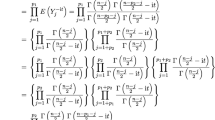Abstract
This article concernsi) the stochastic behavior of the Box-Cox transformation estimator andii) the effect of estimating a transformation on the Box-CoxT-ratio used for the post-transformation analysis. It is shown that the transformation estimator depends on three factors: the model structure, the mean-spread and the error standard deviation σ0. In general, a structured model is able to estimate the transformation very well; an unstructured model can do well also unless the mean-spread and σ0 are both small; and a one-mean mode can give a poor-estimate if σ0 is small. When the sample is not large, it is shown that the unconditional effect of estimating a transformation on the Box-CoxT-ratio is generally small, and the “conditional” effect is also negligible in most of the situations except the case of one-way ANOVA with small σ0. Extensive Monte Carlo simulations are performed to support the theoretical findings.
Similar content being viewed by others
References
Atkinson, A.C. (1985).Plots, Transformations and Regression, Oxford University Press.
Bickel, P.J. (1984). Comment on, The analysis of transformed data.Journal of the American Statistical Association,79, 315–316.
Bickel, P.J. and K.A. Doksum (1981). An analysis of transformations revisited.Journal of the American Statistical Association,76, 296–311.
Box, G.E.P. and D.R. Cox (1964). An analysis of transformations (with discussion).Journal of the Royal Statistical Society, B,26, 211–252.
Box, G.E.P. and D.R. Cox (1982). An analysis of transformations revisited, rebutted.Journal of the American Statistical Association,77, 209–210.
Carroll, R.J., and D. Ruppert (1988).Transformation and Weighting in Regression. Chapman and Hall.
Cohen, A. and H.B. Sackrowitz (1987). An approach to inference following model selection with applications to transformation-based and adaptive inference.Journal of the American Statistical Association,82, 1123–1130.
Cox, D.R. and N. Reid (1987). Parameter orthogonality and approximate conditional inference (with discussion).Journal of the Royal Statistical Society, B,49, 1–39.
Draper, N.R. and D.R. Cox (1969). On distribution and their transformation to normality.Journal of the Royal Statistical Society, B,31, 472–476.
Duan, N. (1993). Sensitivity analysis for Box-Cox power transformation model: contrast parameters.Biometrika 80, 885–897.
Hinkley, D.V. (1975). On power transformations to symmetry.Biometrika,62, 101–111.
Kinkley, D.V. and G. Runger (1984). The analysis of transformed data (with discussion).Journal of the American Statistical Association,79, 302–320.
Hooper, P.M. and Z. Yang (1997). Confidence intervals following Box-Cox transformation.Canadian Journal of Statistics 25, 401–416.
Lawrance, A.J. (1987). A note on the variance of the Box-Cox regression transformation estimate.Applied Statistics,36, 221–223.
Sakia, R.M. (1992). The Box-Cox transformation technique: a review.The Statistician,41, 169–178.
Yang, Z. (1992).Inference following Box-Cox transformation. Ph.D. Dissertation, Department of Statistics and Applied Probability, University of Alberta, Canada.
Yang, Z. (1996). Some asymptotic results on Box-Cox transformation methodology.Communications in Statistics-Theory and Methods,25, 403–414.
Yang, Z. (1997). More on the estimation of Box-Cox transformation.Communications in Statistics-Simulation and Computing,26, 1063–1074.
Yang, Z. (1998). An alternative approximation to the variance of transformation scors.Journal of Statistical Computation and Simulation, (to appear).
Author information
Authors and Affiliations
Rights and permissions
About this article
Cite this article
Yang, Z. Estimating a transformation and its effect on Box-CoxT-ratio. Test 8, 167–190 (1999). https://doi.org/10.1007/BF02595868
Received:
Accepted:
Issue Date:
DOI: https://doi.org/10.1007/BF02595868



